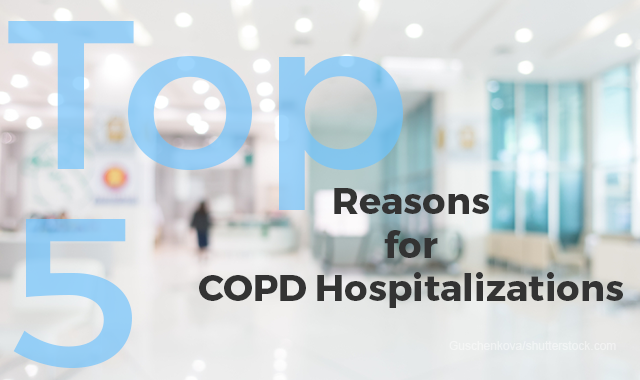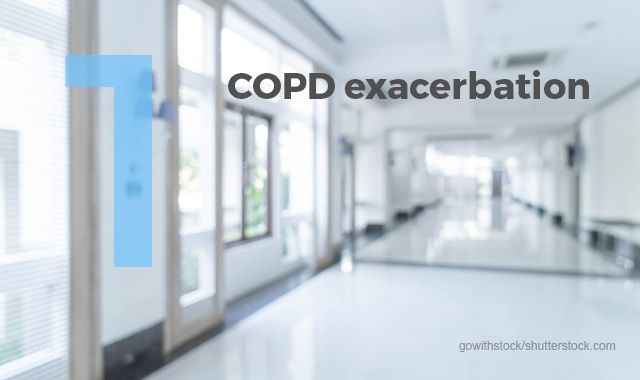Top Five Reasons for COPD Hospitalizations
There are a host of causes for a patient with chronic obstructive pulmonary disease (COPD) to be hospitalized, ranging from pneumonia to infection.


There are a host of causes for a patient with chronic obstructive pulmonary disease (COPD) to be hospitalized, ranging from pneumonia to infection.


The most common reason is a COPD exacerbation, which is defined as “a change in breathing symptoms beyond the normal day-to-day variation,” says M. Bradley Drummond, MD, an associate professor of pulmonary and critical care medicine at the University of North Carolina in Chapel Hill, NC.
Typically, this change in breathing is accompanied by a necessary switch in medications, such as additional inhalers or an initiation of an antibiotic or a steroid. “Sometimes, there is a combination of all three,” says Drummond.
Nearly two-thirds of COPD hospitalizations are associated with a COPD exacerbation, according to Drummond, with an infection being the most prevalent instigator. “Normally, these are viral infections, but they might also be related to bacterial infections,” he says.
Furthermore, some exacerbations can be triggered by inhaling irritants like air pollution, allergens, and dust, which may cause worsening respiratory symptoms.
But there are a substantial number of hospitalized exacerbations that cannot be identified by cause, including an undetectable infection or some other etiology that cannot be teased out.


This second most common cause of COPD hospitalization is at times difficult to separate from an exacerbation. “Because people with COPD have underlying abnormal inflammation in their lungs or have an abnormal lung structure, typically related to smoking, they are more susceptible to both bacterial and viral infections,” says Drummond, director of the Obstructive Lung Diseases Clinic at UNC Health Care. “These infections often settle in and progress to a full-blown pneumonia, characterized by fevers, increasing sputum production, and more shortness of breath.”
Drummond estimates that one in five COPD hospitalizations is due to a pneumonia, typically detected in the emergency room via chest X-ray imaging or CAT scan. “Pneumonia can also have the signs and symptoms of an exacerbation,” he says. “Thus, these two conditions might coexist during a hospitalization.”
However, not all COPD patients with pneumonia necessarily lead to hospital admission.


This is the third most likely cause of hospitalization, specifically heart-related illnesses, with congestive heart failure (CHF) the most prevalent, followed by coronary artery disease and stress on the heart related to impaired blood flow.
“We know that patients with COPD often have other comorbidities frequently related to their prior or current smoking use,” Drummond notes. “These patients can also have swelling of the legs or difficulty lying flat at night due to breathing problems.”
Admitted patients with evidence of fluid accumulation will be administered diuretics to try to remove some of the fluid through the kidney. Likewise, a cardiac catherization may be required to determine the status of the blood vessels feeding the heart.


The fourth most common reason for COPD hospitalization is general respiratory failure; in other words, someone coming into the emergency department struggling with shortness of breath. “This may be caused by exacerbations or pneumonia or CHF,” Drummond says. “The patient has been trying to manage his condition at home for such a long time that he has essentially tired out from his breathing.”

Rounding out the top five reasons for hospitalization is an overwhelming infection. “An infection in the lung may have moved into the bloodstream,” Drummond explains. “Similarly, there may be an infection somewhere else in the body, such as the kidneys or urinary track, which has spread to the bloodstream.”
Because COPD is a lung disease, these patients are unable to compensate for those infections as effectively as the non-COPD population.
“If the infection is identified early, patients will often be started on antibiotics, which can frequently stave off the infection from progressing,” Drummond states.
The average length of hospitalization for a COPD-related complication can vary, but typically is around five to six days.
Doing More and Saving More with Primary in Home Care
September 1st 2021In this week’s episode of Tuning In to the C-Suite podcast, MHE Associate Editor Briana Contreras interviewed VillageMD’s Senior Medical Director of Village Medical at Home, Dr. Tom Cornwell. Dr. Cornwell discussed the main benefits of primary care at home, which includes the benefit of cost savings for patients, maintaining control of hospital readmissions and others. Dr. Cornwell also noted what has changed in the industry of at-home care and if there has been interest from payers like insurance companies and medicare in the service.
Listen
This week on Tuning Into The C-Suite Briana Contreras spoke with Dr. Scott Hayworth, president and CEO of New York-based CareMount Medical. In this interview, the two discussed the importance of patients staying in contact with their doctors for the sake of reducing public health risks and to discuss ongoing care options with them.
Listen